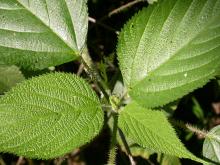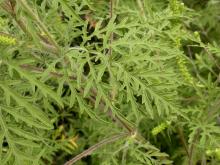Wildflowers, Grasses and Other Nonwoody Plants
Media

Species Types
Scientific Name
Ageratina altissima (formerly Eupatorium rugosum)
Description
White snakeroot looks very similar to thoroughworts, but it has triangular leaf blades that are more broadly angled or rounded at the base. White snakeroot is common statewide. It’s a toxic plant if eaten, so it’s good to be able to identify it.
Media

Species Types
Scientific Name
Ambrosia trifida
Description
Large stands of wind-pollinated giant ragweed commonly form in disturbed areas, causing late-summer misery in the form of hay fever for many Missourians.
Media

Species Types
Scientific Name
Laportea canadensis
Description
Wood nettle, or stinging nettle, often forms dense stands in bottomland forests, streamsides, and other places. There, canoeists, anglers, and others try to avoid touching its stinging hairs!
Media

Species Types
Scientific Name
Sorghum halepense
Description
Johnson grass is a native of the Mediterranean that is invasive in our country. It’s a weed that infests cropland and degrades native ecosystems, and heavy infestations are found in all the major river bottoms of Missouri.
Media

Species Types
Scientific Name
All true grasses (species in the grass family)
Description
Missouri has 276 species in the grass family, including well-known crop plants and our native prairie grasses. Distinguishing between the species can be difficult, but it’s easy to learn some basics about the group.
Media

Species Types
Scientific Name
Geum canadense
Description
White avens, a common wildflower in the rose family, may not catch your eye during hikes, but you will probably notice the seeds clinging to your socks when you get home!
Media

Species Types
Scientific Name
Carex, Schoenoplectus, Scirpus, and other genera
Description
Missouri has more than 200 species in the sedge family. Distinguishing between these grasslike plants can be difficult, but it’s easy to learn some basics about the group.
Media

Species Types
Scientific Name
Ambrosia artemisiifolia
Description
Common ragweed is instantly recognizable by its ornate, 2–3 times pinnately lobed, hairy leaves. You’ve probably seen it many times and wondered what it was.
Media

Species Types
Scientific Name
Subfamily Asclepiadoideae
Description
Milkweeds are a group of plants that used to have their very own family. Now part of the dogbane family, they’re still a pretty distinctive group.
Media

Species Types
Scientific Name
Festuca arundinacea
Description
You’ve seen it a million times, now learn to identify it! Technically an exotic invasive plant, tall fescue is practically everywhere, from lawns to levees, and from pastures to (unfortunately!) prairies.
See Also
About Wildflowers, Grasses and Other Nonwoody Plants in Missouri
A very simple way of thinking about the green world is to divide the vascular plants into two groups: woody and nonwoody (or herbaceous). But this is an artificial division; many plant families include some species that are woody and some that are not. The diversity of nonwoody vascular plants is staggering! Think of all the ferns, grasses, sedges, lilies, peas, sunflowers, nightshades, milkweeds, mustards, mints, and mallows — weeds and wildflowers — and many more!





















